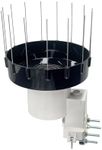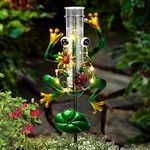Buying Guide for the Best Electronic Rain Gauges
Choosing the right electronic rain gauge can be a bit overwhelming, but with the right approach, you can find the perfect fit for your needs. An electronic rain gauge is a device that measures the amount of rainfall over a period of time. It's a valuable tool for gardeners, farmers, weather enthusiasts, and anyone interested in tracking precipitation. To make an informed decision, you need to consider several key specifications. Understanding these specs will help you determine which rain gauge will best meet your requirements.AccuracyAccuracy refers to how precisely the rain gauge measures rainfall. This is important because accurate data is crucial for making informed decisions, whether you're managing a garden, farm, or simply tracking weather patterns. Accuracy is usually measured in millimeters or inches. High-accuracy rain gauges can measure rainfall to the nearest 0.01 inches or 0.2 millimeters, which is ideal for scientific research or detailed weather tracking. For general use, a rain gauge with an accuracy of 0.1 inches or 1 millimeter is usually sufficient. Consider your need for precision when choosing the accuracy level.
Measurement RangeThe measurement range indicates the maximum amount of rainfall the gauge can measure before it needs to be emptied or reset. This is important for ensuring that the gauge can handle heavy rainfall without overflowing or losing data. Measurement ranges can vary widely, from a few inches to several feet. If you live in an area with frequent heavy rains, choose a rain gauge with a larger measurement range to avoid frequent emptying. For areas with moderate rainfall, a smaller range may be sufficient.
Data Logging and ConnectivityData logging and connectivity features allow the rain gauge to record and transmit data to other devices, such as smartphones, computers, or weather stations. This is important for tracking long-term trends and accessing real-time data remotely. Some rain gauges come with built-in memory to store data, while others can connect to Wi-Fi or Bluetooth for easy data transfer. If you want to monitor rainfall data over time or access it from different locations, look for a rain gauge with robust data logging and connectivity options.
Durability and Build QualityDurability and build quality refer to how well the rain gauge can withstand various weather conditions and physical impacts. This is important because a rain gauge exposed to the elements needs to be sturdy and weather-resistant. Materials like UV-resistant plastic or stainless steel are commonly used for their durability. If you live in an area with harsh weather conditions, such as strong winds or heavy snowfall, choose a rain gauge made from high-quality, durable materials to ensure it lasts longer.
Ease of Installation and MaintenanceEase of installation and maintenance refers to how simple it is to set up and care for the rain gauge. This is important for ensuring that you can quickly start using the device and keep it functioning properly with minimal effort. Some rain gauges come with mounting brackets or stakes for easy installation, while others may require more complex setup. Consider how much time and effort you're willing to invest in installation and maintenance. If you prefer a hassle-free experience, look for a rain gauge that is easy to install and maintain.
Display and ReadabilityDisplay and readability refer to how easily you can read the rainfall measurements from the gauge. This is important for quickly and accurately interpreting the data. Some rain gauges have digital displays that show measurements clearly, while others use analog dials or markings. If you want to read the data at a glance, choose a rain gauge with a clear, easy-to-read display. Consider whether you prefer a digital or analog display based on your personal preference and ease of use.






















